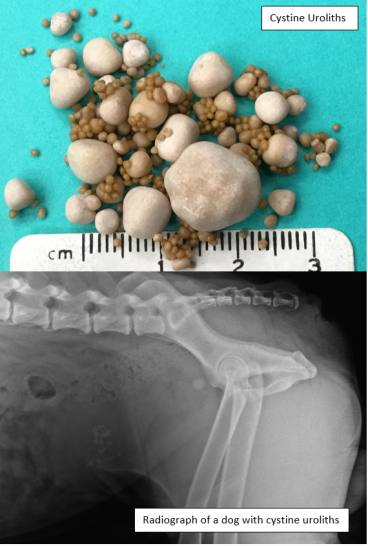Image of the month
Step by Step: Risk Management for Canine Cystine Uroliths

- Predict Mineral Composition
Most dogs with cystine stones are intact males and form their first stone within the first two years of life. Stones vary from radiographically invisible to mildly radiopaque. Cystine (hexagonal) crystals are pathognomonic for cystinuria, but crystalluria is absent in many dogs with cystinuria. - Determine the Underlying Cause
Genetic testing is available for Type 1 variants in Labradors, Newfoundlands, and Scottish terriers; Type 2 variants in Australian cattle dogs and miniature pinschers; and a Type 3 (i.e., androgen dependent) genetic markers in English bulldogs, French bulldogs and mastiffs. In other intact males, freeze a urine sample (≥3 mL) prior to castration for future analysis (i.e., urine cystine-to-creatinine ratio) pending confirmation of stone analysis. - Remove Stones and Castrate Intact Males
Dogs with urethral obstruction require stone removal to prevent reobstruction. Dogs without urethral stones may benefit from medical dissolution. In androgen-dependent dogs, castration alone may be effective. However, the additional use of dissolution foods and cystine chelation will speed up the process. - Initiate Preventative Strategies While Waiting for Stone Results
Two diets are marketed for cystine prevention (Hill’s Prescription Diet u/d and Royal Canin Urinary UC). Consumption of Hill’s Prescription Diet u/d is associated with a 25% reduction in 24-hour urine cystine (Vet Clin N Amer 1999;29:193). - Determine If Castration Reduced Cystinuria in Suspected Androgen-Dependent Dogs
Measure urine cystine and creatinine before and 3 to 6 months after castration. Feed the same pre-castration food for several days before and during collection of the post-castration urine sample. In dogs with androgen-dependent cystinuria, urine cystine-to-creatinine ratios were 40 to 50% lower 3 to 6 months after castration, an indication that castration alone may be sufficient to prevent stone recurrence. If pre-castration urine cystine/creatinine levels are not available, post-castration urine cystine/creatinine ratios below 150 to 200 are consistent with androgen-dependent cystinuria. - Maintain Long-Term Prevention Strategies for Non-Androgen-Dependent Dogs
a. Fed urine-alkalinizing, therapeutic foods with low sodium and low animal protein to reduce cystine precursors (e.g., Hill’s Prescription Diet u/d, others).
b. If needed, adjust urine pH between 7 and 8 using potassium citrate.
c. Mix water with food to lower urine cystine concentration (i.e., USG ≤ 1.020).
d. With multiple recurrences, consider cystine chelators (e.g., alpha-mercaptopropionylglycine).
Additional Resources
How to calculate urine cystine:creatinine ratios?
Treatment Recommendations for Canine Cystine